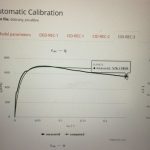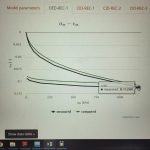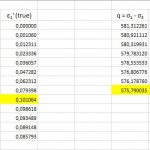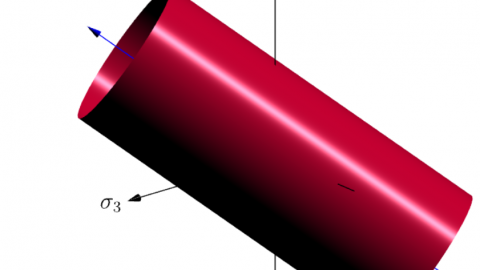Hello all,
According to my last post some weeks ago I now have translated the laboratory data from engineering strain to true strain with the following formula: epsilon(true)=ln(1+epsilon(engineering)). I compared then the the new values of the measurement data with the points on the graph of the ExCalibre output. And they a still different. For the Oedometer the measurement point (sigma 1/epsilon 1 true) is (1200/0,101) and on the graph of ExCalibre it is (1200/0,112). The same is for the triaxial tests. The maximum true strain epsilon 1 of the measurement is 0,197 and on the graph it goes until 0,244. Attached are the pictures of the ExCalibre output with the points and a picture of the excel table with the measurement values.
Is the transformation of strain different in ExCalibre or what can be the reason for that?
Regards Marco
ExCalibre Automatic Calibration
Related Articles
-
Triaxial Callibration test with Hypoplasticity
 pooyan ghasemi||Constitutive Modelling|3 |Views 4,001
pooyan ghasemi||Constitutive Modelling|3 |Views 4,001
Dear all I am trying to calibrate the HP for sand, and I have quite comprehensive data. but they are not totally consistent with each other . we have the […] -
abaqus version
 sobhan abedinnejad||Constitutive Modelling|3 |Views 3,998
sobhan abedinnejad||Constitutive Modelling|3 |Views 3,998
hi every one i’m using abaqus 2017 and i want to implement Hypo-sand to my Biaxial model (2D) and before all, i linked abaqus and fortran successfully my question is […] -
Degradation ( disturbance ) of hypoplastic clay
 jh xue||Constitutive Modelling|0 |Views 302
jh xue||Constitutive Modelling|0 |Views 302
Hi all, I want to do degradation (perturbation) of subplastic clay with ABAQUS, but I can’t do it with umat, changing K,A,sf in ABAQUS has no effect on the result, […] -
Hypoplastic UMAT & Void Ratio
 Hashmi Sohawon||Constitutive Modelling|0 |Views 5,624
Hashmi Sohawon||Constitutive Modelling|0 |Views 5,624
Hi all, Can anyone give a clarification on the material property (parameter 22) in the hypopplasticity umat for clay on Abaqus. My understanding is that these parameters are defined as […] -
-
Challenges in simulating geomechanical models using Mohr-Coulomb with Tension Cut-Off in Abaqus
 Chee Min Leong||Constitutive Modelling|1 |Views 1,695
Chee Min Leong||Constitutive Modelling|1 |Views 1,695
I am modelling an underground cavern for Compressed Air Energy Storage applications using Abaqus. To begin, I attempted to replicate the results presented in the provided paper: Damasceno, DR, Spross, […] -
PM4SAND model
 Mohammad Zarrabi||Constitutive Modelling|3 |Views 4,219
Mohammad Zarrabi||Constitutive Modelling|3 |Views 4,219
Hi all, I have been trying to code the PM4SAND model for several months, but I faced some problems. I was wondering if there is anyone who worked with this […] -
Multi-objective analysis of the Sand Hypoplasticity model calibration
 Francisco Mendez||Constitutive Modelling|0 |Views 932
Francisco Mendez||Constitutive Modelling|0 |Views 932
I am happy to announce that our pre-print paper, “Multi-objective analysis of the Sand Hypoplasticity model calibration”, is available on researchgate (https://www.researchgate.net/publication/369199567_Multi-objective_analysis_of_the_Sand_Hypoplasticity_model_calibration) and Axive (https://doi.org/10.48550/arXiv.2303.07234). In this work, we study […]
Who is Online
No one is online right now
Search SoilModels Website
Recent posts
-
 Degradation ( disturbance ) of hypoplastic clay 23.4.2024
Degradation ( disturbance ) of hypoplastic clay 23.4.2024
-
 Degradation ( disturbance ) of hypoplastic clay 23.4.2024
Degradation ( disturbance ) of hypoplastic clay 23.4.2024
-
 Paper of Coulomb, C. A. (1773) 15.4.2024
Paper of Coulomb, C. A. (1773) 15.4.2024
-
 ABAQUS UMAT of hypoplastic clay model 6.4.2024
ABAQUS UMAT of hypoplastic clay model 6.4.2024
-
 Prague Geotechnical Days 2024 “Geotechnical monitoring” and 30th jubilee Prague Geotechnical Lecture by prof. Eduardo Alonso 5.4.2024
Prague Geotechnical Days 2024 “Geotechnical monitoring” and 30th jubilee Prague Geotechnical Lecture by prof. Eduardo Alonso 5.4.2024
-
 UMAT for Creep-SCLAY model. 1.3.2024
UMAT for Creep-SCLAY model. 1.3.2024
-
 Cyclic tests with Triax element test driver 14.2.2024
Cyclic tests with Triax element test driver 14.2.2024
-
 SUMMER SCHOOL ‘Numerical Modelling in Geotechnical Engineering’, Innsbruck – July 22nd-26th, 2024 1.2.2024
SUMMER SCHOOL ‘Numerical Modelling in Geotechnical Engineering’, Innsbruck – July 22nd-26th, 2024 1.2.2024
-
 COURSE IN SOIL MODELING – NTNU, Trondheim – October 14th to 18th, 2024 21.12.2023
COURSE IN SOIL MODELING – NTNU, Trondheim – October 14th to 18th, 2024 21.12.2023
-
 MSE walls design in Plaxis 11.12.2023
MSE walls design in Plaxis 11.12.2023
-
 sand liquefaction modelling in Anura3D 8.12.2023
sand liquefaction modelling in Anura3D 8.12.2023
-
 BCV bentonite experimental and modelling datasets 14.11.2023
BCV bentonite experimental and modelling datasets 14.11.2023
Recent Comments
- KHA DIDJA on Animating Soil Models
- Jh Xue on Undrained Tests with Clay Hypoplasticity Intergranular
- Zhentao Liu on Problem in simulating CPT using SANISAND04
- Gertraud Medicus on ABAQUS UMAT of hypoplastic clay model
- Chen Zhiming on Download Package of Charles University Implementation of High Cycle Accumulation Model
- Konstantinos Chatzis on Cyclic tests with Triax element test driver
- Abhay Pratap Singh on Cyclic tests with Triax element test driver
- Giovanni Ciardi on Cyclic tests with Triax element test driver
- Konstantinos Chatzis on Cyclic tests with Triax element test driver
- Ismail Khan on Cyclic tests with Triax element test driver
- Kanika Lamba on Cyclic tests with Triax element test driver
- Arie Koot on How to model the settlement in soil due to water drawdown.
- Konstantinos Chatzis on Cyclic tests with Triax element test driver
- Jose Duque on Cyclic tests with Triax element test driver
- MohamadReza Kamali on How to model the settlement in soil due to water drawdown.
- Leo Alibert on MSE walls design in Plaxis
- Ignacio Zuloaga on MSE walls design in Plaxis
- Giada Orlando on Problem with VUMAT interface







Hi Marco, my colleague Tomáš Kadlíček checked ExCalibre code, he will send you more details in a separate comment. Regards David
Hi David, thanks for the quick response.
Regards Marco
Hi Marco, I have checked the source code of ExCalibre and it is correct. In the case of compression, you should calculate strains as follows:
epsilon(engineering) = dL/L0
epsilon(true)= – ln( 1 – epsilon(engineering))
In this way, TRUE strains will be larger then ENGINEERING strains. True strains are related to the current hight of the specimen whereas ENG strains are related to the initial hight “L0”.
Therefore, when subjected to the same amount of settlement “dL” you should always obtain larger strain increment in the case of TRUE strains in comparison to the ENG strains.
Sorry for the misunderstanding.
Kind Regards,
Tomas Kadlicek
Hi Thomas,
now everything fit together. Thanks a lot.
Regards
Marco